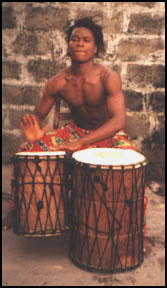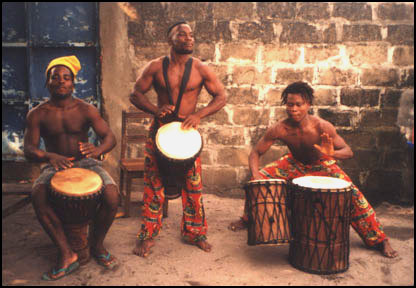 |
 |
||||||||
|
|
Gnonka Marius | Guié Abel | Guié Jerome Oswald | ||||||


Gnonka Marius
Guié Abel
Guié Jerome Oswald
This African drumming group, Gbozé, worked with Whatcom students in 2000 with fantastic results teaching both drumming and dancing. Prior to their work with American students they traveled to Japan, Europe and Canada to teach. They incorporate many Ivoirian traditions in their work including fire dancing and mask dancing. They use traditional precise drumming forms from many different ethnic groups in Côte d'Ivoire.
Beugré Dogny François wrote about African drums: "There are two different kinds of drums: the one used simply for music and the talking drums. My focus here is on the talking drums. These drums are more than simple instruments making sounds. In fact, talking drums are historical evidence for the society using them. In Cote d'Ivoire many ethnic groups use talking drums. One becomes a talking drummer by heritage. This work was very dangerous in the past. In fact, the drummer was not allowed, under penalty of death, to make an error while beating the drum. He must always make the right sound. Making a wrong sound is to spoil the story of the kingdom of his community. The talking drum is the memory of a society. The talking drums are one of the sources of the history of a society. Professor Niangoran-Bouah, a well known retired Ivoirian sociologist from the University in Abidjan, was the first to talk about a science called "Drummologie," the science of drums. He warns that the drums of a society only speak of positive aspects of that society. Therefore, it is necessary to listen to the drums of a society's opponents in order to have complete vision.
The talking drums in general start with a message glorifying the community, the tribe or society. The talking drums of the Avikam of Ebounou for instance start with a glory message to the ancestor who was the leader during the exodus of the clan to the village. The second message is to ask the one who wants to dance to introduce himself to the public. In response there are precise gestures one must do according to his origin. If the dancer does not know the right gestures, he is insulted by the drum and people mock him.
Talking drums are used only during special occasions . . ."
Brian Palmer, music instructor at Whatcom Community College, wrote about African drumming: "Africans have strong beliefs about the status associated with particular instruments and with the spirit of an instrument. In Ghana and many other regions, drums symbolize power and royalty. The number of drums owned by a chief might be indicative of his place in the societal hierarchy. The drum carver and the master drummer (the leader of an ensemble) are both highly regarded. When drums are constructed, rituals are performed so that the spirit of the tree will live in the drum (in one ritual, the tree is given an egg, three leaves, and libations!). Some drums are regarded as the property of a group rather than an individual, are housed in shrines, and are offered sacrifices.
Rhythm and percussion are highly emphasized in African music. Polyrhythms (several different rhythmic patterns occurring simultaneously) are a predominant feature. Rhythm in African music has evolved to be much more complex than rhythm in Western music. Music once considered "primitive" by Westerners is now highly regarded for its rhythmic sophistication and complexity." For Brian Palmer's complete text on African music see the "African Art and Music" file in the WCC historical pages.
|
|
email: anansitravel@yahoo.com
© Anansi